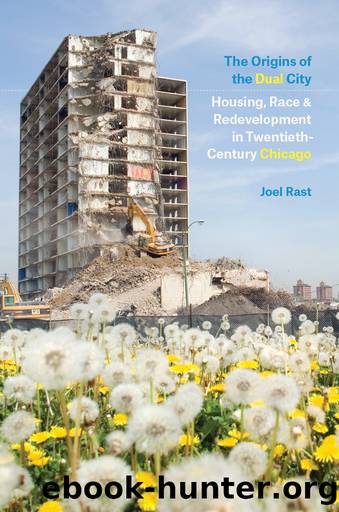The Origins of the Dual City: Housing, Race, and Redevelopment in Twentieth-Century Chicago by Joel Rast

Author:Joel Rast [Rast, Joel]
Language: eng
Format: epub
Tags: Ethnic Studies, Social Science, Political Science, Urban, American Government, Sociology, African American Studies, Local
ISBN: 9780226661582
Google: kySyDwAAQBAJ
Goodreads: 44179344
Publisher: University of Chicago Press
Published: 2019-01-15T11:53:59+00:00
CHAPTER SEVEN
The New Convergence of Power
In 1972 word began leaking to the Chicago media about a new plan for the cityâs central area. It would be the cityâs official plan for the downtown area, but it would be produced not by city planning officials but by the Chicago Central Area Committee. The downtown business group had organized a fundraising drive to cover the entire cost of the $375,000 plan, at the time an unprecedented sum of money for a city plan. Just weeks before it was publicly unveiled in June 1973, one journalist described it gushingly as âthe biggest, most elaborate, costliest plan for central area revitalization in the history of the United States.â1 Titled Chicago 21: A Plan for the Central Area Communities, the plan presented a $15 billion thirty-year program to transform the cityâs downtown and its surroundings in accordance with âa vision of the Central Community of the 21st Century.â2 Major new developments were proposed for the downtown and near-downtown areas. Meigs Airport on the lakefront would be demolished to create new park space and improved access to the lake. A new pedestrian mall was planned for State Street; sidewalks would be widened, with vehicular traffic limited to city buses. Just north of downtown, Navy Pierâa little-used docking structure for lake freighters and passenger boats completed in 1916âwas to be transformed into a lively entertainment area with restaurants, exhibits, and an auditorium. Capping it all off would be a âminiature supercityâ for 120,000 residents built on 650 acres of underutilized land, mostly defunct railroad yards, just south of the Loop. Residents of the new development would be connected to the central business district by a futuristic rapid transit system in which a passenger âwould enter a small car, push a button on a map showing his destination, and zip away automatically.â3
Chicago 21 was the first new plan for the central area produced since the publication of the Development Plan for the Central Area of Chicago in 1958, and it is worth considering for a moment what had changed during the fifteen-year period since the earlier plan was released. The 1958 Development Plan had been prepared during a time when the attack on the slums was still in its infancy. New urban renewal projects such as Lake Meadows and Prairie Shoresâat the time still under construction on the cityâs South Sideâinspired hope on the part of business leaders that areas bordering downtown would soon be targeted for a similar upgrading. Through a combination of new public housing developments and private construction under the urban renewal program, the cityâs political leaders promised to eliminate slums and blight wherever they existed, and downtown business elites looked forward to a time when the cityâs central business district would be the economic center of a city of stable, well-kept neighborhoods. Some areas would, of course, be more prosperous than others, and those would ideally be located close to the central business district. However, even families of little means would at least live
Download
This site does not store any files on its server. We only index and link to content provided by other sites. Please contact the content providers to delete copyright contents if any and email us, we'll remove relevant links or contents immediately.
The Secret History by Donna Tartt(18188)
The Social Justice Warrior Handbook by Lisa De Pasquale(11957)
Thirteen Reasons Why by Jay Asher(8461)
This Is How You Lose Her by Junot Diaz(6451)
Weapons of Math Destruction by Cathy O'Neil(5841)
Zero to One by Peter Thiel(5498)
Beartown by Fredrik Backman(5369)
The Myth of the Strong Leader by Archie Brown(5243)
The Fire Next Time by James Baldwin(5024)
How Democracies Die by Steven Levitsky & Daniel Ziblatt(4966)
Promise Me, Dad by Joe Biden(4911)
Stone's Rules by Roger Stone(4866)
100 Deadly Skills by Clint Emerson(4695)
A Higher Loyalty: Truth, Lies, and Leadership by James Comey(4556)
Rise and Kill First by Ronen Bergman(4548)
Secrecy World by Jake Bernstein(4393)
The David Icke Guide to the Global Conspiracy (and how to end it) by David Icke(4386)
The Farm by Tom Rob Smith(4329)
The Doomsday Machine by Daniel Ellsberg(4250)
